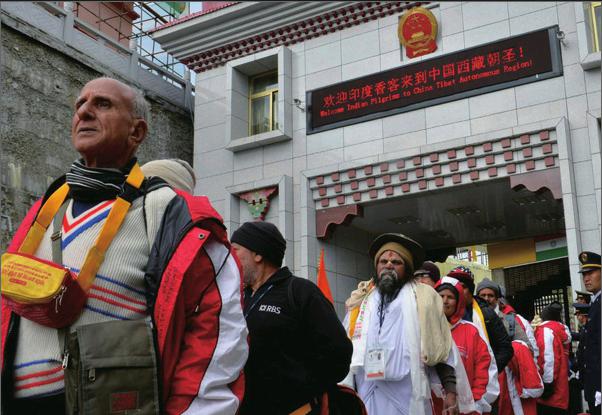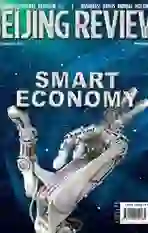The Power of Mutual Understanding
2018-02-09ByLiuZongyi
By+Liu+Zongyi

As the two largest developing countries in the world, China and India share the common goals of boosting their economies and improving their peoples lives. Shouldering the common responsibilities of maintaining regional peace and stability while facilitating the rise of Asia, the two countries also share extensive common interests in promoting a multi-polar world and better democratization of international relations.
With rapid economic growth and a remarkable rise in international status, the two countries have greatly improved bilateral relations, which shed signifi cant light in the global community.
From a world perspective, the more global role China-India relations play, the more mutual trust and coordination between the two are required, and more misunderstandings should be cleared up.
It has become a great challenge for both countries to reverse any hint of deterioration in their bilateral relations.
Great potential
Xi Jinpings thought on major-country diplomacy with Chinese characteristics plays an important guiding role in the development of China-India relations.
Xi Jinping, General Secretary of the Central Committee of the Communist Party of China (CPC), stressed in his report to the 19th CPC National Congress held in Beijing last October: “China has actively developed global partnerships and expanded the convergence of interests with other countries. China will promote coordination and cooperation with other major countries and work to build a framework for major country relations featuring overall stability and balanced development. China will deepen relations with its neighbors in accordance with the principle of amity, sincerity, mutual benefit, and inclusiveness and the policy of forging friendship and partnership with its neighbors. China will, guided by the principle of upholding justice while pursuing shared interests and the principle of sincerity, real results, affinity, and good faith, work to strengthen solidarity and cooperation with other developing countries.”
Xi also noted that the CPC will strengthen exchange and cooperation with political parties and organizations of other countries and encourage peoples congresses, the military, local governments, and peoples organizations to engage in exchanges with other countries, showing the great importance of people-to-people exchanges in promoting relations between countries.
For China and India, two major countries that are also neighbors, it is particularly important to consolidate the civil and social basis of bilateral relations through people-topeople exchanges.endprint
Tracing the development path of ChinaIndia relations, especially since the turn of the 21st century, we see Indian local governments attitudes contrast with those of the federal government on developing relations with China. Local leaders attach great importance to improving economic ties and cultural exchanges with China as well as attracting investments from China. For example, many chief ministers of Indian states have conducted investment roadshows in China.
In addition, people-to-people exchanges between the two countries remain relatively meager in both scale and range. Due to the lack of substantial exchange, mutual understanding and trust between the two peoples as well as the space and form of exchange also need to be expanded.
So, developing friendly relations with India by promoting people-to-people exchanges is a tremendously signifi cant factor in the establishment of strategic mutual trust between the two countries and the improvement of their bilateral political relations.
Over the past decade, people-to-people exchanges between the two countries have developed rapidly and made some landmark achievements.
For instance, after Xis visit to India in September 2014, China opened a new route along the Himalayan Nathu La Pass for pilgrims traveling from India to Tibet. However, considering the massive populations of both countries, the present direct contact is still relatively little. Furthermore, nationallevel political relations between China and India are likely to remain somewhat chilly for quite some time, so a vigorous expansion of people-to-people exchanges is even more necessary.
Methods to expand
The focus of people-to-people exchanges should shift from the state level to the local level. China should recognize the various attitudes of Indian local governments and nongovernmental organizations and strengthen exchanges with them, especially those that have already established friendly relations with China.
Additionally, there needs to be innovation in methods and forms of promoting people-to-people exchanges. In recent years, potential conduits have evolved drastically in both form and content.
Many friendly Indian organizations have encountered problems at various levels, including aging personnel, lack of funds and organizational shrinkage, which make it harder to carry out substantive exchanges.
In fact, facing the further and acute development of globalization, some nongovernmental organizations, professional institutions and cultural foundations have become increasingly active, creating a new force for promoting people-to-people exchanges.endprint
However, due to the lack of docking organizations in China, organizations in each country have not been able to communicate well. This presents a great opportunity to innovate working methods for institutions engaged in non-governmental exchanges, such as the Chinese Peoples Association for Friendship with Foreign Countries.
At the same time, people-to-people exchange activities based on large-scale bilateral and multilateral platforms are another emerging trend. For example, peopleto-people exchanges have become a major pillar of BRICS cooperation development. To follow the developmental trend, institutions engaged in non-governmental exchanges should optimally utilize available platforms by planning ahead and responding actively.
Active efforts should be made to expand media exchanges between the two countries. Chinese non-governmental institutions for exchanges should play a bigger role in promoting media exchanges between the two countries by greatly promoting communications and cooperation between journalists and news agencies.
For example, some large bilateral and multilateral cultural activities could be organized to attract the attention of the media. Promoting exchanges between the fi lm and television industries could deliver real and positive information and increase mutual understanding between the peoples of both countries.
A few months ago, the Indian fi lm Dangal became a big hit in China. China-India co-productions are not anything new for audiences in the two countries, but there is still a lack of such fi lms that can touch the hearts of audiences on both sides. The love story of the legendary Indian physician Dr. Dwarkanath Shantaram Kotnis and his Chinese wife Guo Qinglan may well serve as a perfect theme of such a co-production.endprint
